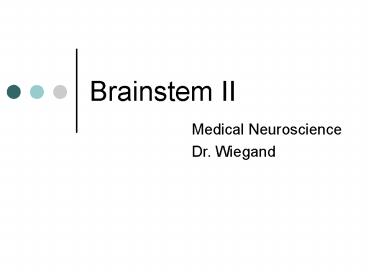Brainstem II - PowerPoint PPT Presentation
Title:
Brainstem II
Description:
Carotid body sensation (GVA) caudal solitary n. ... GVA Caudal Solitary nucleus. GSA Trigeminal (TBNC) SSA Cochlear and Vestibular nuclei ... – PowerPoint PPT presentation
Number of Views:205
Avg rating:3.0/5.0
Title: Brainstem II
1
Brainstem II
- Medical Neuroscience
- Dr. Wiegand
2
Internal Brainstem
- Cranial nerve nuclei
- Location of selected tracts
- Reticular formation
3
Developmental Organization
4
Developmental Organization
Sulcus Limitans
5
Developmental Organization
From Pritchard Alloway Fig. 4-1
6
(No Transcript)
7
Cranial Nerve Nuclei Organization
- Medial to sulcus limitans
- GSE ? SVE ? GVE
- Lateral from sulcus limitans
- VA ? GSA ? SSA
8
Generalizations
- Sensory nuclei lateral to sulcus limitans
- Motor nuclei medial to sulcus limitans
- Visceral nuclei are on either side of sulcus
- Innervation of skeletal muscle (GSE SVE) most
medial - General and special visceral afferent nuclei in
same column
9
Cranial Nerves Telencephalon Diencephalon
I, II
- Olfactory
- smell (SVA)
- Optic
- vision (SSA)
10
Cranial Nerves Mesencephalon
III, IV
- Oculomotor
- extraocular eye muscles (GSE) oculomotor
nucleus - PSNS to eye (GVE) Edinger-Westphal nucleus
- Trochlear
- extraocular muscle (sup. oblique) (GSE)
trochlear nucleus
11
Cranial Nerves Metencephalon
V, VI
- Trigeminal
- Masticatory muscles (SVE) trigeminal motor
nucleus - General sensation of the head and face (GSA)
trigeminal complex - Abducens
- extraocular muscle (lat. rectus) (GSE) abducens
nucleus
12
Cranial Nerves Metencephalon
VII
- Facial
- Facial expression muscles (SVE) facial motor
nucleus - Glands (submandibular, sublingual lacrimal)
(GVE) superior salivatory lacrimal nucleus - Taste (SVA) rostral solitary nucleus
- General sensation of ear (GSA) trigeminal
complex
13
Cranial Nerves Metencephalon
VIII
- Vestibulocochlear
- Hearing (SSA) dorsal and ventral cochlear
nuclei - Balance (SSA) vestibular nuclei
14
Cranial Nerves Mylencephalon
IX
- Glossopharyngeal
- Stylopharyngeus muscle (SVE) n. ambiguus
- PSNS to parotid gland (GVE) inferior salivatory
n. - Taste (SVA) rostral solitary n.
- Carotid body sensation (GVA) caudal solitary n.
- General sensation from ear tongue (GSA)
trigeminal complex
15
Cranial Nerves Mylencephalon
IX
- Vagus
- Muscles of larynx pharynx (SVE) n. ambiguus
- PSNS to thorax and upper abdomen (GVE) dorsal
motor n. of X (DMV) - Sensory from viscera (GVA) caudal solitary n.
- Taste (SVA) rostral solitary n.
- General sensation from ear (GSA) - trigeminal
complex
16
Cranial Nerves Mylencephalon
XI, XII
- Accessory
- innervates trapezius and sternocleidomastoid (SVE
or GSE) motor nucleus of XI in upper cervical
cord - Hypoglossal
- tongue muscles (GSE) hypoglossal nucleus
17
Cranial Nerve Nuclei Groups
- GSE SVE Motor Nuclei of
- III, IV, V, VI, VII, XI, XII
- ambiguus
- GVE Parasympathetic Nuclei
- Edinger-Westphal nucleus
- Lacrimal salivatory (superior, inferior) nuclei
- Dorsal Motor Nucleus of X
- SVA (Taste) Rostral Solitary nucleus
- GVA Caudal Solitary nucleus
- GSA Trigeminal (TBNC)
- SSA Cochlear and Vestibular nuclei
18
Number Name Function Nucleus Peripheral Ganglia PeripheralTarget
I olfactory smell - olfactory bulb Nasal cavity
II optic vision lateral geniculate body retina Retina
III oculomotor Motor PSNS oculomotor Edinger-Westphal none ciliary Extraocular mm Constr. Pup ciliary
IV trochlear Motor Trochlear None Superior oblique
V trigeminal Motor Sensory motor V SpV, PrV, mesV none trigeminal Mm of mastication Sensory of face
VI abducens Motor abducens none Lateral rectus mm
VII facial motor PSNS taste sensory facial superior salivatory - rostral solitary trigeminal none submandibular and sphenopalatine geniculate Mm facial express Lacrimal gland Submandibular/lingual Tongue External ear
VIII vestibulocochlear hearing balance cochlear (dorsal, ventral) vestibular spiral vestibular Cochlea Vestibular app
IX glossopharyngeal motor PSNS taste sensory sensory n. abiguus inferior salivatory rostral solitary caudal solitary trigeminal none otic inf. (petrosal) of IX inf. (petrosal) of IX Mm of larynx Parotid gland Tongue Soft palate pharynx External ear
X vagus motor PSNS taste sensory sensory n. ambiguous dorsal motor rostral solitary caudal solitary trigeminal none multiple inf. (nodose) of X inf. (nodose) of X sup. (jugular) of X Mm of larynx/pharynx Viscera Epiglottis Viscera sensory External ear
XI accessory motor accessory nucleus none Trap SCM
XII hypoglossal Motor Hypoglossal None Tongue mm.
19
Learning Internal Anatomy
http//lansing.bellarmine.edu/pt/atlas/cover.html
- Recognize outline of brainstem
- Midbrain
- Inferior vs. superior colliculi
- Pons
- Medulla
- Open vs. closed
- Place nuclei in correct level
- Recognize orientation of slice
- Learn Pathways
- Relationship of tracts
- Places of decussation
20
(No Transcript)
21
(No Transcript)
22
ASCENDING PATHWAYS
23
DESCENDING PATHWAY
24
CRANIAL NERVES
25
Other Brainstem Nuclei
26
Reticular Formation
- Diffuse, poorly differentiated brainstem nuclei
- Occupies tegmentum of brainstem
- Modulates
- Pain
- Muscle tone and reflexes
- Autonomic functions e.g. respiration, blood
pressure, cardiac function - Arousal, awareness and attention
27
(No Transcript)
28
Midline Raphe Nuclei
- Mostly serotoninergic cells send and receive
extensive ascending and descending projections - Regulate pain, arousal and sleep
29
Parasagittal medial nuclei
- Motor regulation
- Medial (facilitates extensors) reticulospinal
tract - Lateral (facilitates flexors) reticulospinal
tract - Also autonomic regulation
- ARAS exerts excitatory input to cortex for
consciousness and attention
30
Locus Ceruleus Medial Reticular Zone
- Regulates attention
- Inhibits pain at spinal cord level
- Regulates autonomic function
31
Parasagittal Lateral Nuclei
- Receives input to mediate visceral and cranial
nerve reflexes - Projects to parasagittal medial nuclei
- Pedunculopontine n.
32
Pedunculopontine Nucleus
- Acetylcholine projecting cells
- Ascending projection to inferior frontal
cortex/intralaminar n. - Input from basal ganglia output nuclei
- Projects to brainstem motor nuclei (VST, RST)
33
Wallenbergs Syndrome
Lateral medullary syndrome
Thrombosis of PICA
34
Wallenbergs Syndrome
- Structures involved
- Inf. Cerebellar peduncle (ipsilateral ataxia)
- SpV tract nucleus (ipsilateral loss pain
temperature) - Anterolateral system (contralateral loss of body
pain temperature) - N. ambiguus (dysphagia dysphonia)
- Vestibular n. (nystagmus and postural instability)
35
Well































